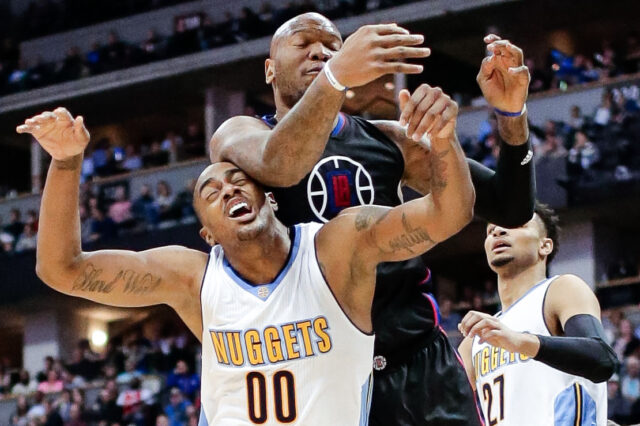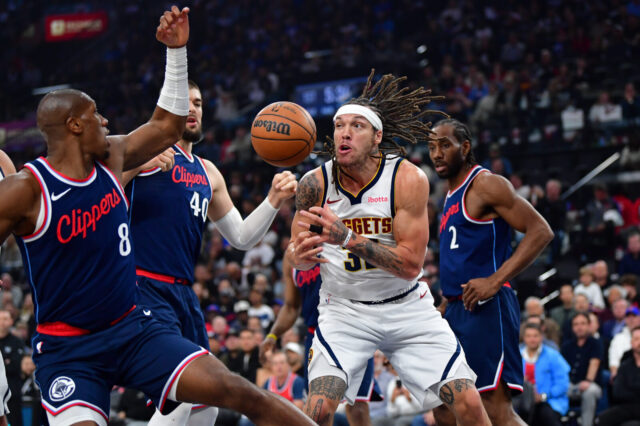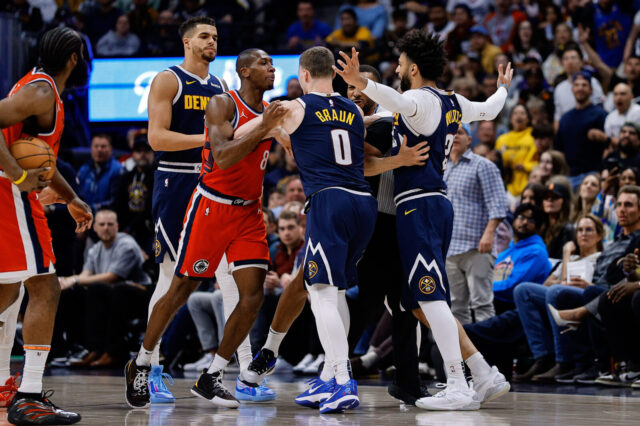Jokic-Murray PnR role reversal
One of the hard parts about utilizing a unicorn is that there isn’t a blueprint for how such a unique player should be used. There’s never been a Nikola Jokic. His closest comp, Arvydas Sabonis, retired 15 years ago in a league that was drastically different than the one that exists today. As much as there are things that remain true and unchanged about the game over the course of 15 years, there is also a lot of experimentation going on around the league right now and the need to try new things.
The Nuggets have stumbled onto a pretty interesting wrinkle that might actually be worth exploring further in the future: having Jamal Murray screen for Nikola Jokic in pick-and-roll (PnR). It’s somewhat rare to use your point guard as a screener and almost unheard of to use your center as the ball-handler in the PnR but Murray and Jokic might provide the perfect pairing for this to work. For starters, point guards aren’t used to defending the screener in PnR. Similarly, centers aren’t used to fighting over screens in the PnR, so immediately you are placing two defenders into unfamiliar territory.
In the clip below, you can see how lost Myles Turner gets when Murray screens for Jokic and then slips down into open space for the easy bank shot.
It’s not an action you’d run 20 times per game, but it might be something to keep in the playbook for special occasions or as a free-flowing wrinkle in more fluid offensive possessions. At the very least, it shouldn’t be an action Denver is afraid to try if an opportunity arises within the flow of he offense.
Patient aggression
The word “aggressive” has been thrown out a lot lately with regards to the Nuggets but “patient aggression” is sort of the oxymoron that describes the style of play that best suits this team. The two clips below demonstrate this idea very well. First, the opening play against the Indiana Pacers:
Let’s break down all of the shots Denver passed up and grade each potential shot based on value.
- Murray comes off of the screen but sees the defense has defended him well. Potential shot quality: D-.
- Millsap catches on the reversal and considers isolating his man from the wing. Potential shot quality: C-
- Jokic thinks about a isolating from the extended low block. Potential shot quality: C
- Jokic thinks about trying to draw a foul that had a fairly low chance of getting called. Potential shot quality: C-
- Will Barton drives to the basket. Shot quality: A+
It isn’t that Jokic and Millsap weren’t being aggressive, it’s that they trusted that they’d be able to find a better shot in the flow of the offense. The same is true even when the Nuggets are slow to establish a rhythm in the half court.
Once again we can count the shooting opportunities.
- Jokic can take an early shot clock three-pointer: B-
- Millsap can try to drive into a crowded paint: C+
- Torrey Craig can either shoot a mildly contested three or drive toward the paint for a contested drive: C-
- Barton can force a pull-up jumper off of the PnR: C+
- Jokic can shoot a mid-range jumper: B+
- Millsap gets an uncontested dunk: A+
Denver has such talented players that the end result of 20 seconds of patient aggressiveness is often an A+ shot. The trick is avoiding the temptation of settling for those early shot clock B- attempts while still hunting for transition offense. It’s a delicate balance but Denver is at their best when they err on the side of patient.
Collapsing the paint twice
Speaking of patience, this play below was a great example of how a team gains an advantage every time they spread the floor and collapse the paint. The Muray-Jokic PnR draws four defenders into the paint but proper spacing around the perimeter forces all four guys to relocate and close-out on their man when Murray resets the play. That opens the door for the second drive into the paint which results in a beautiful running bank shot. Just keep your eyes on how hard the five Pacers defenders have to work on this possession and how the paint opens up for Millsap on his drive.
Lonzo screens
A few weeks ago I talked about a read that I dubbed the “Lonzo Screen.” It referred to a great play that Lonzo Ball made against the Nuggets which ultimately resulted in an offensive rebound and putback. There’s an adage in basketball that if you want to get open for a shot, set a screen for somebody else. This idea is often true of offensive rebounding on the weak side since setting a screen away form the ball often results in the defense getting lost and leaving you open to crash the boards.
That’s exactly what happened in both clips below. In the first, you can see how everyone on the Bucks assumes that someone else is responsible for Juancho Hernangomez. That’s what screening does, it makes the defense think. Juancho times it perfectly and he gets open for the rebound. The second clip is similar in that Millsap opens up a shot for someone else by setting a hard screen but when the help defender switches out onto the corner shooter, Millsap becomes open on the offensive glass.
Jokic on the double
Just look at how quickly Jokic reads the defensive rotations on this post up. The pass leaves his hand so quickly. There are some good passing big men in the NBA but Jokic is in a class all his own.
Jokic playing possum
If there is one thing that Jokic’s success can teach young basketball players it’s that you don’t always have to be fast to be effective. Much more important is how you change speeds. Jokic does the opposite of most centers when he catches on the roll or when he catches on a kickout in that, rather than explode towards the rim, he takes one quick step and then really slows things down before making his read.
This serves a couple of purposes. First, the awkward rhythm throws the defense off. The help side defenders expect Jokic to meet them at the rim but he never gets there. Second, it gets Jokic under control to make one of his favorite shots, a 7-foot touch shot that is somewhere between a layup, a floater, and a short jumper. Lastly, it allows Jokic to play possum with the help defenders. Play at the same pace and the help can time when to rotate over to contest the shot and when to stay close to their man to take away the kickout or dropoff. When Jokic slows down like this, the defender gets trapped guessing what they are supposed to do.
Jokic’s body is slower than every player he goes against, but his mind is always much faster.
Ram Stagger BS
The Nuggets have found a pet play for Devin Harris and Mason Plumlee.
This play has been in their playbook for several years, most notably as a Kenneth Faried staple. It starts with a “ram” screen, in which Plumlee sets a pindown for a wing. That wing then fakes (and sometimes actually sets) a ball screen but is followed immediately by a Plumlee ball screen. What this does is disguise the ball screen and forces the defense to guess which player will be the one defending the PnR. Lately, the play has worked to get Plumlee a lob rolling to the rim.
The Nuggets tweak the play when Jokic is involved since Jokic probably can’t catch a lob. Instead, the first screener makes contact on the screen right as Jokic sets the second screen. It forces the defense to make several calculations at once and results in the Jokic equivelant of a lob: a standing push shot from 5-feet away from the basket.
Juancho’s nose for the ball
Juancho has such great instincts on the offensive end. This play is simple enough but basketball is a simple game when players understand how to space the floor and when it’s their time to shoot, pass, or dribble. Watch how quickly Juancho gets to his spot on the break and how quickly he makes the swing pass when the kickout arrives. He’s already read the floor by the time the ball touches his fingertips. As a bonus, watch how perfectly he slides into rebounding position once the shot goes up.
Plays like this don’t show up for him in the box score but it’s a great example of a guy doing his job, even if that job is a simple one.


